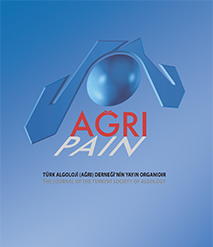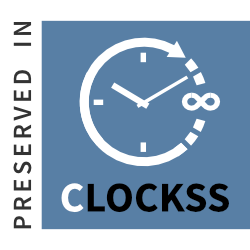Quick Search
Volume: 24 Issue: 4 - 2012
| EXPERIMENTAL AND CLINICAL STUDIES | |
| 1. | The characteristics and subtypes of headache in relation with age and gender in a rural community in Eastern Turkey Gülçin Benbir, Derya Karadeniz, Baki Göksan PMID: 23364776 doi: 10.5505/agri.2012.85579 Pages 145 - 152 Headache is a frequent and widespread symptom constituting a major health problem at all age groups, though vast differences are present according to the age and gender, as well as population characteristics. In this hospital-based study, we investigated the characteristics and subtypes of headache with relation to age and gender in a rural community in eastern part of Turkey. A total of 11549 subjects were evaluated, and 4951 patients (42.8%) had headache. The 1-year headache prevalence was 38.6% in children, 47.0% in adults, and 23.3% in elderly (p<0.001). The female to male ratio was higher in adults (p<0.001) and elderly headache patients (p<0.001), but not in children (p=0.654). The most common diagnosis was frequent episodic tension-type headache in all. The headache attributed to epileptic seizure and rhinosinusitis were about three times more common in children, while chronic tension-type headache was about three times more common in adults and elderly. While 60% of patients with migraine were male in children, about 80% of patients were females in adults. The understanding of the epidemiology of headache and subtypes is important as it constitutes one of the major health problems due to its high prevalence at all age groups. |
| 2. | The role of pericranial muscles in the succesful management of episodic tension type headache Ömer Karadaş, Avni Babacan, Levent Hakan Gül, İlker Hüseyin İpekdal, Ülkü Türk Börü PMID: 23364777 doi: 10.5505/agri.2012.57704 Pages 153 - 158 Objective: Peripheral and central nociceptive mechanisms are responsible in the development of Tension Type Headache (TTH). Analgesics are frequently used in the treatment of acute TTH. Antidepressants are used in the prevention. In this study, therapeutic efficacy of local application of lidocaine was investigated in Episodic Tension Type Headache (ETTH) patients. Materials and methods: ETTH patients with pericranial tenderness (n=20, Group 1) and without pericranial tenderness (n=20, Group 2) were included into our study. Three sessions of local injection of 1% lidocaine were performed in both groups. Two-sided intramuscular injections of 1 mL were applied for each patient. The muscles were frontal, temporal, masseter, sternokloidomastoid, semispinalis capitis, splenius capitis and trapezius muscles. Patients were evaluated in 1st, 2nd. and 3th months. The number of painful days per month and pain intensities were recorded according to Visual Analog Scale (VAS) before and after the treatment Results: Of the patients; 11 were males and 29 were females. The mean ages of Group 1 and Group 2 were 35.95 ± 9.85 (18-53) and 34.85 ± 10.04 (20-54) years respectively. There was no difference between the groups in terms of age, gender, pain frequency and pain intensity (p> 0.05). The frequency and severity of pain was significantly lower in pericranial sensitive ETTH patients at 1st, 2nd. and 3th months after local lidocaine injections compared with ETTH patients having pericranial tenderness (p <0.05). Conclusions: Local lidocaine application can be used as an effective method in the treatment of ETTH patients with pericranial tenderness. |
| 3. | Comparison of Ultrasound guided supraclavicular and infraclavicular approaches for brachial plexus blockade. Yavuz Gürkan, Tülay Hoşten, Murat Tekin, Sertan Acar, Mine Solak, Kamil Toker PMID: 23364778 doi: 10.5505/agri.2012.38247 Pages 159 - 164 Ultrasound-guided supraclavicular and infraclavicular blocks are commonly used for upper extremity surgery. The primary aims of our study were to compare block success, block onset times and performance times, secondary aims were to compare the number of needle advancement, and incidence of adverse events of ultrasound-guided supraclavicular or infraclavicular blocks. Methods: 110 patients were randomized into two groups: supraclavicular (Group S) and infraclavicular (Group I). All the patients were administered 20 ml 0.5% levobupivacaine and 10 ml 2% lidocaine as mixture of local anesthetics. The sensory score of the seven terminal nerves was assessed every 10 min for 30 min. Results: Block success (Group I: % 92.7; Gorup S: % 83.6) and block onset time (Group I: 12.5±4.8; Group S: 11.6±3.9 min) were similar between the groups. Block performance time was shorter in Group I, than Group S (194.4±65; 226.3±59 sec, (P<0.05). The numbers of needle advancement were lower in Group I than Group S, (p<0.05). The Group I patients had a significantly better block of the median and ulnar nerves than Group S and Group S patients had a better block of the medial cutaneous nerve, than Group I (p<0.05). Horner syndrome was observed in 9 patients (16.3%) and paresthesia in one patient (1.8%) in Group S. Conclusions: Similar block features was observed with infraclavicular and supraclavicular approaches but infraclavicular block may preferable to supraclavicular block due to the lower incidences of transient adverse events. |
| 4. | The risk factors of patient’s have low back pain applied to policlinic of Algology department Pınar Ünde Ayvat, Osman Nuri Aydın, Mustafa Oğurlu PMID: 23364779 doi: 10.5505/agri.2012.38258 Pages 165 - 170 Purpose: To study the risk factors that triggered the low back pain such as age, gender, marital status, occupation, education level, smoking and alcohol consumption of patients who applied to Algology Polyclinic. Material and Method: The patients’ age, gender, occupation, marital status, education, economic level, smoking and alcohol consumption are asked and entered in to “Pain Assessment Form”. When the education levels were questioned, their last education level is asked; when their economic level was questioned, the answers of patients were considered without restricting them between limits. Results: Out of 772 patients, 200 of them had mechanical low back pain. 23,5% had hernia nucleous pulposus, 20% had facet joint degeneration, 18,5% had narrow spinal channel, 7,5% had sakroiliac joint degeneration, 20,1% had more than one pathology, 10,5% had other pathologies. Low back pain did not differ according to age and gender. Students had significantly low, whereas workers had significantly high low back pain (p=0,005). Of the patients with low back pain, 170 of them were married, 30 widow or single (p=0,059). With higher education the pain significantly decreased (p=0,001). With low economic levels, more pain was examined (p=0,042). There was a correlation between low back pain and smoking (p=0,030, but there was not any correlation between low back pain and alcohol consumption (p=0,638). Conclusion: Lower education, lower economic level, to work in heavy jobs and smoking were correlated with low back pain. It was concluded that by taking precautions that lower risk factors, low back pain can be decreased. |
| 5. | Pediatric nurses view about parental presence during children’s painful procedures Handan Boztepe PMID: 23364780 doi: 10.5505/agri.2012.58561 Pages 171 - 179 Family- centered care is one of the basic principles of pediatric nursing and allows pediatric patients having parental support during invasive procedures. But, health care professionals hesitate about parental presence during pediatric invasive procedure. The aim of this descriptive study is determining the views of nurses about parental presence during children’s invasive procedures. This study was conducted between the dates 15th March and 15th July 2009 in a university hospital in whose clinics allowed to parental stay in Ankara. The total number of the nurses accepted to participate in the research is 43 (57%). Demographic data form, open and close ended interview questionnaires were used in the study. The majority of nurses reported that the parents should have not be present with the child during the painful procedure. The disadvantages of parental presence during a painful procedure commonly expressed by the nurses respectively; increased level of children’s anxiety (77.1%), increased level of health professional’s anxiety (60.0%) and detrimental effect of parental presence on the success of the procedure (60.0%). The nurses’ recommendations due to make less traumatic of the painful procedures for both site of children and their parents are respectively; explaining the procedure to the children and parents (83.7%), doing local anesthesia or sedation before procedure (37.2%) and performing the painful procedures by specialized teams (20.9%). |
| 6. | Levobupivacaine for Postoperative Pain Management in Circumcision; Caudal Blocks or Dorsal Penile Nerve Block Züleyha Kazak Bengisun, Perihan Ekmekci, Ahmet Hakan Haliloglu PMID: 23364781 doi: 10.5505/agri.2012.21931 Pages 180 - 186 Purpose: In this study, we evaluated the analgesic efficacy and adverse effect profile of levobupivacaine in caudal and DPNB in postcircumcision pediatric patients. Methods: Sixty boys between 2-10 age undergoing circumcision were enrolled. The patients were divided into two groups; Group C (n=30) and Group P (n=30) were applied caudal block and dorsal penile nerve block (DPNB), respectively. Blocks were performed before surgery as a supplement to general anesthesia with 1 mL kg-1 0.25% levobupivacaine. Postoperative pain and sedation scores were assessed on the 10th, 30th minutes, 1th, 2 th, 3 th, 4 th, 5 th and 6th hours. The number of pain free patients for the first 6 hours, duration of analgesia, time to first analgesic administration, walking, micturition, and total paracetamol demands, and length of stay were recorded. Results: Demographic data were similar between groups. The number of children who spent the first 6 hours pain free was larger in Group C than Group P (p=0.0001). The time to first analgesic (p=0.000033) and walking (p=0,004) were longer in Group C. There were 14 patients with motor block in Group C (p=0.00007). In view of AUC; FPRS, OPS and MPOPS were significantly better in Group C on the first postoperative 6 hours. Conclusion: Caudal block done by using levobupivacaine for postoperative pain management in circumcision is more successful than penile block; however there is a significant delay in time to first walking and as might be expected there is a risk for motor block. |
| CASE REPORTS | |
| 7. | Convulsion due to application of low dose meperidine: a case report Halit Özkaya, Abdullah Barış Akcan, Gökhan Aydemir, Mert Akbaş PMID: 23364782 doi: 10.5505/agri.2012.68542 Pages 187 - 190 Meperidine is an opiod analgesic used in a variety of clinical situations. The active metabolite, normeperidine, is a central nervous system excitatory agent and has the ability to cause irritability, hyperreflexia, tremor, myoclonus and seizures. Previously identified risk factors fort he development of meperidine–related seizures include renal failure, high meperidine dosages and co-adminestration of hepatic enzyme inducing medications or phenothiazines which decreases seizure treshold. Patients with normal renal function rarely manifest seizure activity when given meperidine. Here we report a 10 years old boy with femur fraction whom had normal renal function and we used low dose meperidine due to post operative pains. |
| 8. | Ultrasound Guided TAP Block For The Treatment of Postoperative Prolonged Pain - An Alternative Approach Perihan Ekmekçi, Züleyha Kazak Bengisun, Baturay Kansu Kazbek, Serdar Han, Filiz Tüzüner PMID: 23364783 doi: 10.5505/agri.2012.82905 Pages 191 - 193 Transversus abdominis plane (TAP) block is a relatively new regional anesthesia technique in which T7-12 intercostal nerves, ilioinguinal and iliohypogastric nerves, cutaneous branches of L1-3 nerves are blocked between the internal oblique and transversus abdominis muscles. This technique is mostly used for the treatment of acute postoperative pain following abdominal surgery. In this case report, we evaluate the usage of TAP block in prolonged pain following upper abdominal surgery. |
| LETTER TO THE EDITOR | |
| 9. | A Brachial Plexus Variation Identified During Ultrasound-Guided Interscalene Block Alper Kılıçaslan, Yavuz Gürkan, Murat Tekin PMID: 23364784 doi: 10.5505/agri.2012.34966 Pages 194 - 195 We report a brachial plexus variation identifıed during performance of an ultrasound-guided interscalene Block. |





